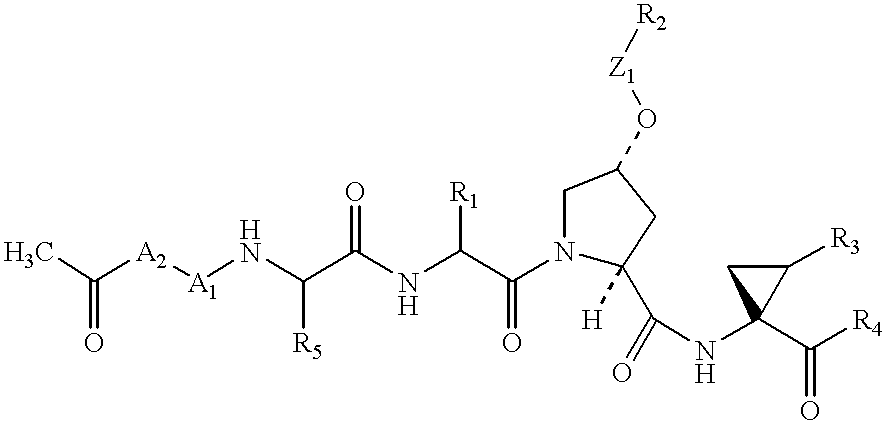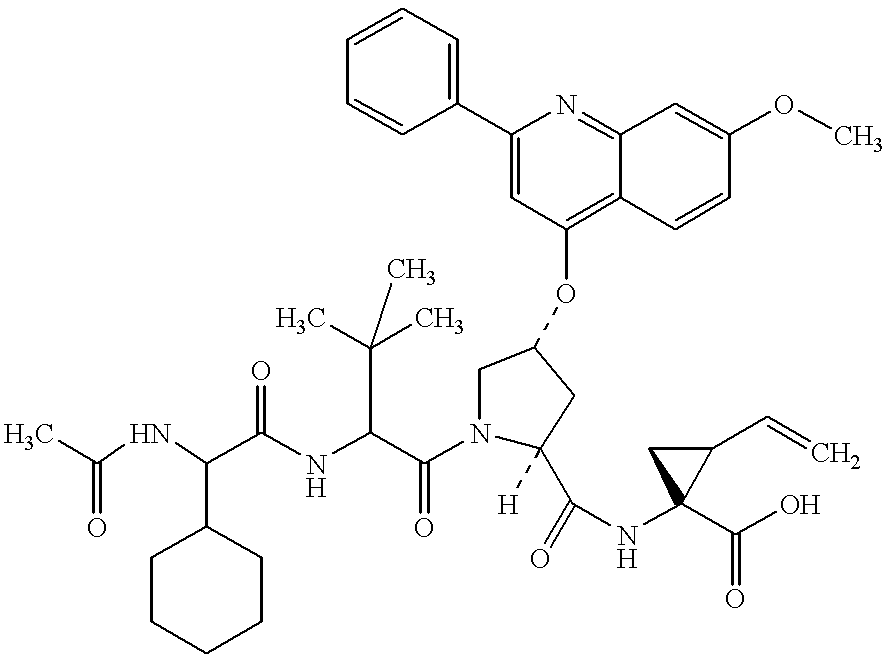Imidazolidinones as NS3-serine protease inhibitors of hepatitis C virus
a technology of hepatitis c virus and ns3serine protease, which is applied in the direction of drug compositions, peptide sources, peptide/protein ingredients, etc., can solve the problems of low sustained response rate of therapies, frequent side effects, and poor treatment progress of patients with hcv infection, so as to reduce friction or wear, prevent caking, and high melting point
- Summary
- Abstract
- Description
- Claims
- Application Information
AI Technical Summary
Benefits of technology
Problems solved by technology
Method used
Image
Examples
examples 1
Preparation of compound of Formula 1
##STR50##
A solution of compound 1a (10.0 g, 37.8 mmol) in pyridine (18 mL), t-BuOH (14 mL) and CHCl.sub.3 (25 mL) was cooled at -15.degree. C. for 10 minutes, followed by dropwise addition of phosphorous oxychloride (4 mL). The resulting solution was stirred at -15.degree. C. for 30 minutes, then warmed to room temperature for 4 hrs. The solution was then washed with H.sub.2 O, 1% cold HCl, saturated NaHCO.sub.3, and brine. The combined organic layer was dried over Na.sub.2 SO.sub.4, concentrated to dryness and purified by column chromatography on silica gel, eluting with 35% EtOAc / 65% CH.sub.2 Cl.sub.2 to give compound 1b (11.0 g, 91% yield). ##STR51##
To a stirred solution of compound 1b (2.45 g, 15.2 mmol) in DME (35 mL) was added K.sub.2 CO.sub.3 (2.1 g, 15.2 mmol), EtO.sub.2 C--CH.sub.2 Br (3.4 mL, 30.7 mmol) and a small amount of tetra-n-butylammonium iodide. The resulting solution was stirred at room temperature overnight and concentrated to...
example 2
Preparation of Compound of Formula 2
##STR55##
The desired product 2a was prepared in 60% isolated yield, as described above for Example 1, Step B, using ethyl-4-bromobutyrate as the alkylating agent. ##STR56##
The desired product 2b was prepared in quantitative yield, as described above for Example 1, Step C. ##STR57##
To a stirred solution of starting material 2b (0.174 g, 0.46 mmol) in CH.sub.2 Cl.sub.2 (5 mL) was added A (0.113 g, 0.51 mmol), EDCl (0.106 g, 0.552 mmol), HOBt (0.085 g, 0.552 mmol) and NMM (0.177 mL, 1.61 mmol). The resulting solution was stirred at -20.degree. C. for 48 hrs. The solution was then washed with satd. NaHCO.sub.3, 10% aq. citric acid and brine. The combined organic layer was dried over Na.sub.2 SO.sub.4 and purified by column chromatography using 5 / 95 MeOH / CH.sub.2 Cl.sub.2 to give product 2c (0.082 g, 71% yield, MH.sup.+ =547.3). ##STR58##
The desired product 2 was prepared in 78% isolated yield, as described above for Example 1, Step E. HRMS (FAB) Calcd...
example 3
Preparation of Compound of Formula 3
##STR59##
To the starting material 1a (10.50 g, 39.74 mmol) in benzene (100 mL) was added benzyl alcohol (10.30 mL, 99.35 mmol) and p-toluenesulfonic acid (1.52 g, 7.95 mmol). The reaction mixture was refluxed overnight. It was then cooled to room temperature and washed with saturated NaHCO.sub.3 solution and brine. The organic layer was separated, dried (Na.sub.2 SO.sub.4) and concentrated. The residue was dissolved in minimum amount of EtOAc and then hexanes was added to this solution. The white solid which crashed out was filtered and dried to give 8.2 g (58%) of pure product 3a. ##STR60##
The desired product 3b was obtained from 3a using the procedure described for Example 1, Step B. Purification of the crude material using 10 / 90 EtOAc / dichloromethane provided 3b in 74% yield. ##STR61##
A solution of 3b (1.29 g, 2.93 mmol) in 30% HBr in AcOH (5 mL) was stirred at ambient temperature for 20 min. It was then poured slowly into a stirred solution of...
PUM
| Property | Measurement | Unit |
|---|---|---|
| v/v | aaaaa | aaaaa |
| temperature | aaaaa | aaaaa |
| temperature | aaaaa | aaaaa |
Abstract
Description
Claims
Application Information
 Login to View More
Login to View More - R&D
- Intellectual Property
- Life Sciences
- Materials
- Tech Scout
- Unparalleled Data Quality
- Higher Quality Content
- 60% Fewer Hallucinations
Browse by: Latest US Patents, China's latest patents, Technical Efficacy Thesaurus, Application Domain, Technology Topic, Popular Technical Reports.
© 2025 PatSnap. All rights reserved.Legal|Privacy policy|Modern Slavery Act Transparency Statement|Sitemap|About US| Contact US: help@patsnap.com



